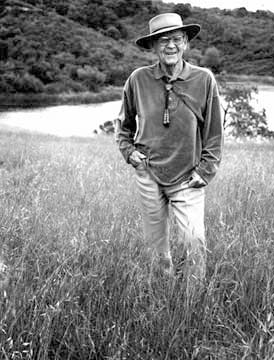Oakmead Herbarium Group
The history of the herbarium vascular plant collection, including its initial formation by Prof. John Thomas creating a lab collection from Dudley Herbarium sheets, is described by Jewett (2005) Documenting Plant Diversity: Jasper Ridge's Herbarium. For Stanford's rich botany heritage see Timby (1998) The Dudley Herbarium: its origin, fate, and legacy at Stanford. Also Neisser (2018) Historical Timeline of the Dudley Herbarium. In 2024 JRBP Associate Director of Research Adriana Hernandez succeeded Nona Chiariello as Oakmead Herbarium Coordinator.
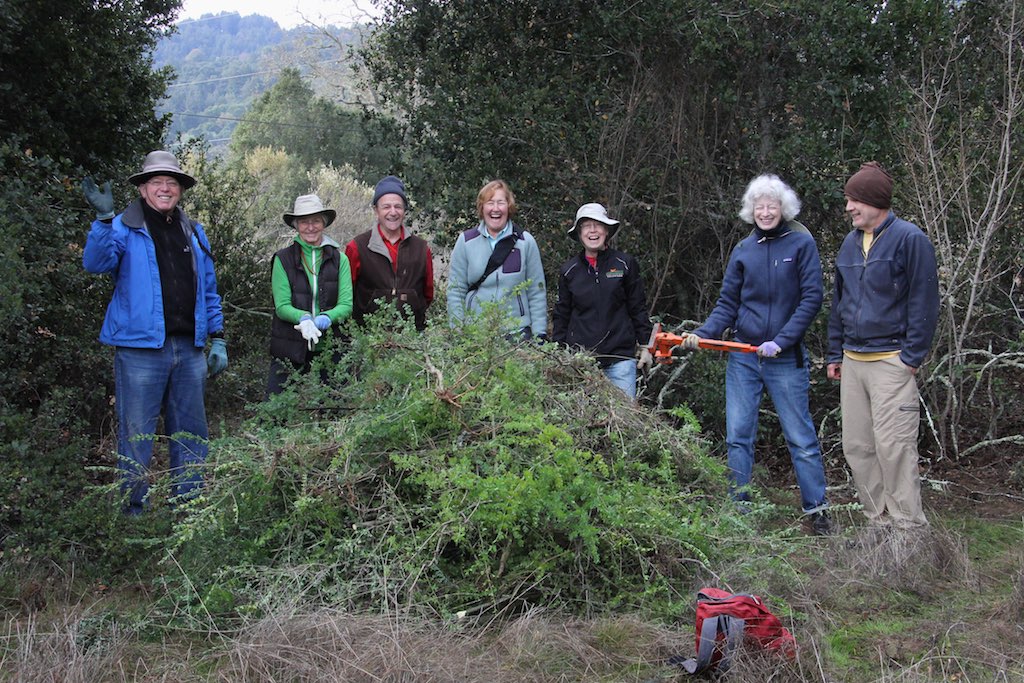
Carl, Diane, Flip, Dawn, Rebecca, Ann, John. Photo by Alice Cummings, 2019
Associate Director of Research and Oakmead Herbarium Coordinator
Herbarium docents, research affiliates
Alice Cummings (docent class of 2010) specializes in photographing the flora and fauna of Jasper Ridge. Previously a resource manager at Midpeninsula Regional Open Space District, she finds Jasper Ridge an ideal local place to pursue her interest in natural history and photography. Rocky Mt. Biological Laboratory, where she spent many summers, and backpacking in the high Sierra Nevada are other favorites. Until the recent Preserve Pandemic-related shutdown, she participated in weekly preserve walks with the herbarium team, taking pictures of everything of interest. Alice has posted over 12,600 JRBP photos on Flickr as of December 2020, mostly vascular plants and their habitats, plus 875 animals, 395 arthropods, 668 lichen, 452 fungi and 153 galls. To access these and other herbarium team photos, start on the Oakmead Herbarium Vascular Plant list, or the Photo Archive page, or go directly to Flickr and search by typing JRBP and scientific or common name, family, trail, date or combinations of these categories -- or view an album of her plant photo favorites.
Paul Heiple, 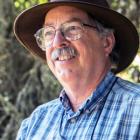 keen observer with broad natural history knowledge enthusiatically shared, is once again a group regular after retiring in 2019 as Grassroots Ecology staff botanist. In that position he managed volunteers in habitat restoration, led nature hikes, and taught classes to students and volunteers of all ages. A retired petroleum geologist who spent his career exploring for oil in the Williston Basin of North Dakota, he now focusses on the smaller landscapes of Jasper Ridge and nearby Palo Alto Arastradero Open Space and Edgewood Preserve. Paul has been volunteering for over 20 years with the Friends of Edgewood Preserve, co-leading a model program of habitat restoration. At Jasper Ridge he is a long-term field worker in the biannual ant survey. Paul has also served as chair of the Conservation Committee of the Town of Portola Valley, co-chair of the San Mateo County Weed Management Area, and treasurer of the California Native Plant Society Santa Clara Valley Chapter. He is active with the California Invasive Plant Council, and mentors local Boy Scout troops.
keen observer with broad natural history knowledge enthusiatically shared, is once again a group regular after retiring in 2019 as Grassroots Ecology staff botanist. In that position he managed volunteers in habitat restoration, led nature hikes, and taught classes to students and volunteers of all ages. A retired petroleum geologist who spent his career exploring for oil in the Williston Basin of North Dakota, he now focusses on the smaller landscapes of Jasper Ridge and nearby Palo Alto Arastradero Open Space and Edgewood Preserve. Paul has been volunteering for over 20 years with the Friends of Edgewood Preserve, co-leading a model program of habitat restoration. At Jasper Ridge he is a long-term field worker in the biannual ant survey. Paul has also served as chair of the Conservation Committee of the Town of Portola Valley, co-chair of the San Mateo County Weed Management Area, and treasurer of the California Native Plant Society Santa Clara Valley Chapter. He is active with the California Invasive Plant Council, and mentors local Boy Scout troops.
Ken Hickman is an independant naturalist and camera trapper who works on contract and as a volunteer for agencies and organizations in the Santa Cruz Mountains and statewide, including Stanford University's Conservation Program. Ken’s projects and publications are listed on his iNaturalist profile. A major interest is the Santa Cruz kangaroo rat and its role as a keystone species in chaparral. The species historically occurred as far north as Belmont, including on Jasper Ridge, was relocated on Midpeninsula Regional Open Space District lands by Ken, and is now the subject of the research project featured on a recent OpenRoad program. Another interest, Ken and his frequent field companion John Rawlings have focussed on assessing the status of locally uncommon and rare plants in the Santa Cruz Mountains, which has incidentally provided added emphasis to the floristic richness of JRBP. His JRBP iNat records document results of many Preserve field trips, during which Ken has discovered a number of previously undocumented occurrences such as Persicaria hydropiperoides and Hesperevax acaulis ambusticola and relocated plants unreported for decades such as Pentachaeta alsinoides and Navarretia mellita
We habitually carried Thomas [Santa Cruz Mountains flora] and Matthews [Monterey County flora]. Keyed on the trail often. Those were very fine, pleasant, quiet, serious days with Carol [Zabel] -- Ann Lambrecht, 2021
Ann has done over twenty years of fieldwork on the Preserve. A member of the first docent cohort taught by the local-legend naturalist and artist Herb Dengler, she also worked with the incomparable field person Carol Zabel. She is an important collector contributing 127 sheets of 97 taxa to the Oakmead Herbarium and first documented several plants including Ehrharta erecta and the locally rare Wolffia columbiana (with Paul Heiple) and Pleuropogon californicus. For a number of years Ann managed with Toni Corelli curation of herbarium specimens and accesion of new material (894 vascular plant specimens for the years 2000 to the present). She maintained the first digital inventory of Oakmead vouchers and managed with Toni the transition to CCH2. For many years Ann has also volunteered at the California Academy of Sciences Herbarium working on different projects ranging from mosses to Chiapas vascular plants.
Ann retired from her professional job in early 2000 not having visited the ridge regularly for more than twenty years, other than to lead a few tours each year. She recalls:
Carol kindly allowed me to join her quest to find every plant on the Preserve plant list published in 1998 by Ruth and Toni. We walked twice a week for a couple of years, then dropped back to once a week, when we were joined first by Toni and then John, and a few years later by other docents/affiliates. Carol and I thought ourselves far too lowly to collect (we seldom even went off trail). It was Toni who began collecting during these walks, opening our eyes to the obvious: what we were seeing should be recorded by herbarium specimens in addition to field notes. Years later it was also Toni who proposed that the herbarium should be part of CCH (Consortium of California Herbaria) and then CCH2.
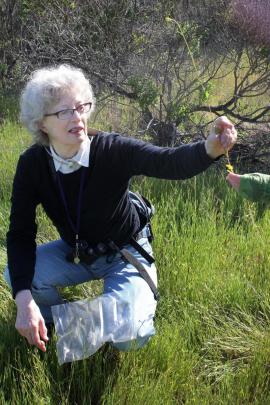
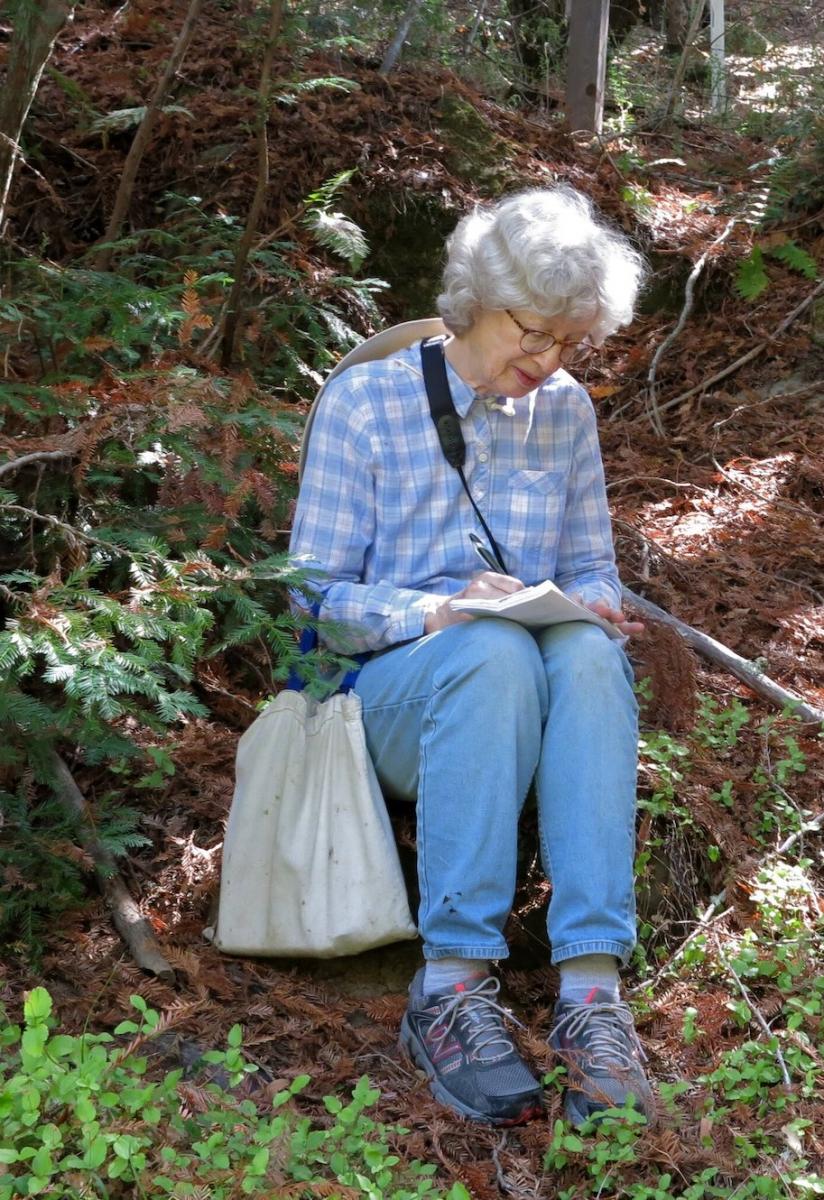

Ann in her natural habitats. Photographs by Alice Cummings, 2011-1014. Diane and Ann in the herbarium.
Dawn Neisser is a graduate of BIO EARTHSYS 105 class of 2016. Her class project focussed on mapping Festuca california at Jasper Ridge. Having retired from a career in the tech industry, she assists the Herbarium Group as the administrator of the Oakmead Herbarium data within the Consortium of California Herbaria data portal. She is interested in expanding and promoting the information available from the herbarium data, for ongoing and future research, including the imaging of herbarium specimen sheets (completed in 2023).
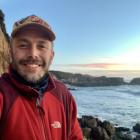
Jorge Ramos earned a PhD in Environmental Life Sciences with a focus on carbon cycling from wetland ecosystems. He is also Executive Director of Jasper Ridge Biological Preserve. Jorge has supported the work of the Herbarium group in many ways and we are fortunate to have another strong voice among staff supporting our fieldwork and curation of the Oakmead Herbarium's collections of lichens, bryophytes, and vascular plants, representing 150 years of local collecting.
John Rawlings has collected extensively at Jasper Ridge beginning in 2004. He created and maintains the Oakmead Herbarium website and, with Sairus Patel, Trees.stanford.edu. He is also a member of the Preserve birding group monitoring the High Grasslands transect. John and naturalist/phototrapper Ken Hickman are currently working on an inventory of locally rare plants in the Santa Cruz Mountains Bioregion, in collaboration with botanists Toni Corelli and Dylan Neubauer. A former volunteer at the California Academy of Sciences Herbarium, like his botany buddies Ann Lambrecht and Sara Timby, he contributed the Cyperaceae treatment to the revised Flora of San Francisco, to be published by the Academy.
Diane Renshaw cannot remember a time when she was not interested in plants and wildlife. She grew up back east, has a degree in wildlife ecology, and enjoyed a 35-year career running her own environmental consulting practice, doing field work throughout California and the west. Diane has served as interim editor of Fremontia, the journal of the California Native Plant Society, and edited a revision of Philip Munz's Desert Wildflowers for the U.C. Press Natural History series. She is certified as a Senior Ecologist by the Ecological Society of America. Since 2008 Diane has been a docent at Jasper Ridge and a member of the herbarium group, where she has been indulging her recent interest in lichens, adding to the Jasper Ridge collection started by Janet Doell, and periodically teaching a continuing education class on the subject. She has also contributed important collections of new or uncommon vascular plants to the Oakmead Herbarium.
Rebecca Reynolds is a graduate of the BIO EARTHSYS 105 docent class of 2015. A former teacher at Peninsula School in Menlo Park, she chose to create an instructive lesson and walk on mosses as her class project. Immediately following she made a study of mosses at 6 locations on the preserve. As a docent she especially enjoys leading walks for school groups. As a member of the Herbarium Group she has helped updating the docent manual, the vascular plant list, and vouchering some species of Rosa and Trifolium. She also organized and completed notes on the Oakmead Herbarium bryophyte collection, and has added 5 new taxa to the collection including Hennediella stanfordensis and Wiessia controversa. She is also a docent at Edgewood Park and Natural Preserve.
Sara Timby, trained in anthropology, ethnobotany and linguistics at UC Berkeley and University of Alberta, has worked for the Canadian Northwest Territories researching Athabascan material culture, for USGS as a geobotany field assistant on indicator plant species of uranium ores, Open-File Report 86-409, and for the Stanford Libraries cataloging manuscripts. She published a history of Stanford botany and the Dudley Herbarium, and curated the exhibit and wrote the book The Orchid Observed: Five Centuries of Botanical Illustration (1983). Sara has been a Jasper Ridge Docent since 1988, an ex-officio member of the herbarium group, participating in a wide range of projects from archaeology, floristic monitoring, Dirca restoration, and transcribing Herb Dengler’s field notebooks. She is a life-long mountaineer who has made numerous ascents in the U.S., Canada, and Europe.
Other affiliates:
Mary Bernstein, Carl Cheney, Teal Derrer, Perry McCarty
Former affiliates
Toni Corelli, Botanist, Curator Emeritus of the Carl Sharsmith Herbarium
Toni Corelli retired in 2016 after 31 years as an active Jasper Ridge docent and plant specialist. During 21 of those years she served as associate curator of the Oakmead Herbarium and Collections. Toni curated the Herbarium with the late Ruth Porter, who organized the collection and later oversaw its move to the Leslie Shao-ming Sun Field Station. The initial collection of some 5,000 herbarium sheets and unmounted pressed plants has grown to 6,000+ specimens. Toni annotated most of these sheets.
In addition, with enthusiasm and dedication she did much more. She developed and maintained, with Ann Lambrecht, the Herbarium and plant databases, promoted our membership in the Consortium of California Herbaria, taught numerous classes for docent trainees, docents, and others in the Jasper Ridge community, and contributed with other Herbarium team members to numerous research projects. Although retired from her work at Jasper Ridge, Toni is still engaged with native plant activities in and around Half Moon Bay and the San Mateo Coast.
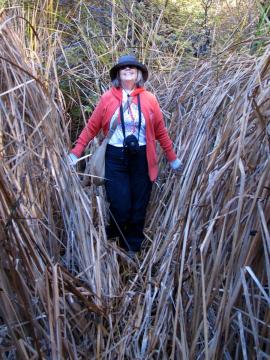 1982-2017 -- Rare and Endangered Plant Chairperson, California Native Plant Society Santa Clara Valley Chapter. Located and documented rare and endangered plants and communities in San Mateo and Santa Clara Counties. Responded to county, state and federal agencies regarding environmental impacts to rare and endangered plants and plant communities. Responded to state and federal agencies regarding consideration for listing of rare and endangered plant species. Wrote petitions to California Department of Fish and Game for protection of rare and endangered plants with recommendations for management. She was the driving force organizing members to do rare plant surveys and petition for the rare plant listings for Edgewood Preserve. The listing of the Leptosiphon croceus on the San Mateo County coast in 2018 was also a major achievement. Toni was CNPS Santa Clara Valley Chapter Vice-President in 1983; and President, 1984-1985.
1982-2017 -- Rare and Endangered Plant Chairperson, California Native Plant Society Santa Clara Valley Chapter. Located and documented rare and endangered plants and communities in San Mateo and Santa Clara Counties. Responded to county, state and federal agencies regarding environmental impacts to rare and endangered plants and plant communities. Responded to state and federal agencies regarding consideration for listing of rare and endangered plant species. Wrote petitions to California Department of Fish and Game for protection of rare and endangered plants with recommendations for management. She was the driving force organizing members to do rare plant surveys and petition for the rare plant listings for Edgewood Preserve. The listing of the Leptosiphon croceus on the San Mateo County coast in 2018 was also a major achievement. Toni was CNPS Santa Clara Valley Chapter Vice-President in 1983; and President, 1984-1985.
- 1989-2005 -- Consultant California Coastal Conservancy; Midpeninsula Regional Open Space District (MROSD); Nature Conservancy (TNC); Peninsula Open Space Trust (POST); San Francisco Watershed; Sempervirens Fund; State of California.
- 1994-2015 -- Curator, Carl W. Sharsmith Herbarium, San Jose State University.
- 1999-2009 -- Continuing education instructor of ecology, natural history and botany classes at various colleges, universities and other groups, including Stanford University Continuing Studies and Friends of Edgewood Preserve.
Photograph: Toni botanizing Middle Lake, by Alice Cummings, 2011
Publications
- Corelli, T., Chandik, Z. 1995. The rare and endangered plants of San Mateo and Santa Clara County: with photographs and illustrations. Half Moon Bay, CA: Monocot Press.
- Corelli, T. 2002. Flowering plants of Edgewood Natural Preserve. Half Moon Bay, CA: Monocot Press.
- Corelli, T. 2004. Flowering plants of Edgewood Natural Preserve. 2nd ed. Half Moon Bay, CA: Monocot Press.
- Corelli, T. 2005. Illustrated Field Guide to the Woody Plants of the Santa Cruz Mountains. Half Moon Bay, CA: Monocot Press.
- Corelli, T. 2005. San Francisco Watershed Vascular Plant List. Half Moon Bay, CA: Monocot Press.
- Boutell, A., Corelli, T., Frost, N. 2009. Plants and Plant Communities of the San Mateo Coast. San Mateo Coast Natural History Association.
- Corelli, T. 2010. Trifoliums of San Mateo and Santa Clara County. Half Moon Bay, CA: Monocot Press.
- Corelli, T. 2011. Checklist of the Vascular Plants of San Mateo and Santa Clara Counties, California. Santa Clara Valley Chapter, CNPS.
Jasper Ridge Biological Preserve Stanford University Plant List. 4th ed. , n.,>
Teri Barry, 2010 - 2018. Collection Manager, UC Davis Herbarium Jul 2018 -. "I worked with the Herbarium group to document plant distribution. Other Jasper Ridge activities included field work for my thesis, and the biannual Argentine ant survey for four seasons."
Kaisa Eckelmeyer, inputting 2014-2016 historical field notes dating back to 1975.
Catherine Magill graduated BIO EARTHSYS 105 (Ecology and Natural History of Jasper Ridge Biological Preserve) class of 2018 and has offered numerous docent-led hikes on the Preserve and participates in the Jasper Ridge Backyard Camera Trapping project setting up motion-activated cameras on her Portola Valley property. She is Vice-Chair of the Conservation Committee of the Town of Portola Valley, California Naturalist 2019, Master Gardener, San Mateo County, and Certified water-efficient landscaper / irrigation auditor.
In Memoriam
Phillip (Flip) Dibner (2023) was an ecologist with a long-standing interest in ecological succession and other aspects of landscape ecology, and in applying technology to assist collection, collation, and analysis of data to elucidate these fields. His academic credentials include degrees in Biology and Ecology from Yale. After working as a consulting ecologist, pursuing doctoral studies in the Biophysics Group at UC Berkeley, and a stint in industry as a software engineer / scientist, Flip engaged with the international Open Geospatial Consortium, which develops and promotes interoperability standards for data with spatial content. Here he founded and for more than ten years chaired the Natural Resources and Environment Working Group (now the Earth System Science Working Group). In this capacity, he facilitated collaboration with Biodiversity Information Standards (an international education and scientific association formerly known as the Taxonomic Databases Working Group) and participated in the Biogeomancer project and the early development of the Darwin Core Standard for sharing and re-use of biodiversity data. He has also contributed to projects with the National Center for Ecological Analysis and Synthesis. Flip became a docent in 2018. His project on slime molds enhanced our awareness of these understudied life forms.
Judy Mason (2022) A great friend to many at Jasper Ridge known for her beautiful botanical illustrations and photographs, an inspiring teacher and her love of flowers. So many will remember walking the trails with her. Don Mason, her husband of more than 50 years, was with her when she suffered a stroke last week. He appreciates everyone's thoughts, well wishes and shared memories. See you on the trail Judy Mason. (Toni Corelli)
<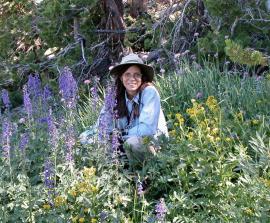
An avid birder known for her capacious, reliable memory, Carol was one of Jasper Ridge's most accomplished plant-hunters, in the tradition of naturalist Herb Dengler and botanist John Hunter Thomas. After the distribution of the first vascular plant database in 1998, she began walking the trails in the Preserve to find and record plant locations. Ann Lambrecht joined her in 1999. Together Carol and Ann tracked down dozens of "missing plants" and recorded field notes for hundreds more. Carol also collected 89 voucher sheets, the most recent in 2007, representing 79 typically unusual taxa at Jasper Ridge, frequently plants she had rediscovered. One can read about some of her explorations in the serial Trail Notes in the Jasper Ridge newsletter Field Notes. Also see the entry for Ann Lambrecht, Carol's trail companion. Some of her other JRBP Field Notes articles on specific topics:
Plant regrowth in the controlled burn. ,>- Zabel, C. 2002. Plant survey of Hermit's Cabin site and area bordered by Road F and trail to Goya Gate.
- Zabel, C. 2003. Index for the Duncan Porter Report, 1962, and Additions, J.H. Thomas, 1971.
Plants growing on serpentine areas that need to be protected. ,>- Zabel, C. 2003. Plants found and identified in JRBP by Carol Zabel/Ann Lambrecht since my last list of 9/6/02.
- Zabel, C. 2003. Jasper Ridge oaks and hybrid oaks. In Oakmead Herbarium Oak Notes.
Sally Casey (1921–2019)
Sally reviewed and annotated the Poaceae sheets in the early 2000s. This project involved about 10% of all herbarium sheets. The 100+ grasses comprise about 12% of the Jasper Ridge flora. Sally was one of a kind -- active and sharp to the very end. She will be remembered as a botanist for her teaching skills and grass ID field trips, and also as a horticulturalist -- for her backyard nursery, where she patiently raised annuals and shooting stars to support CNPS, and for her skills in raising fruits and vegetables, a legacy from her youth on a farm in Illinois. In 1972 she co-founded our CNPS chapter, along with several similarly inclined friends, and was our first Vice President. Later she held many positions in the chapter, including Field Trip chair and Gardening with Natives chair. Sally was named a CNPS Fellow in 1997, the highest honor bestowed on Society members. Sally had a Bachelor’s degree in music, but went on to receive a Master's degree in botany from San Jose State, and later taught there and at Mission and Foothill Colleges. She was also a U.C. Cooperative Extension Master Gardener and active in the California Rare Fruit Growers and the Western Horticultural Society. Sally Casey, CNPS Fellow
“Winkie” Lennihan (1929–2016)
An important collector at Jasper Ridge from 1980 to 1990, focussing on graminoids, Winifred Hadden “Winkie” Lennihan, ’50 (history), of Santa Barbara, Calif., June 23, 2016 at 87. She married a Marine who became a successful attorney in San Francisco, and together they raised three children before his death in 1981. For many years, she cultivated her interest in natural history, devoting time to studying plants, watching birds and fly-fishing. In 1996, she married again and she and her second husband traveled the world, enjoyed sailing and playing golf. Survivors include her children, Dave, Robert and Martha.
Ruth's many contributions to Jasper Ridge Biological Preserve were made with a cheerfulness and efficiency that all who knew her will miss for a long time to come. A member of the 1976 docent class, she gained an extensive understanding of the preserve's natural history, with a particular focus on its flora. She became sought after as a teacher, committee member, and organizer. Perhaps most notably, she took on management of the several thousand plant specimens left to the preserve by Stanford professor John Thomas. With Toni Corelli, she shaped these into the Oakmead Herbarium and Collections in the Sun Field Station. Ruth was actively occupied with this work until the end of her life. She was dedicated, effective, and a wonderful friend. Read Eliza Jewett (2005) Documenting Plant Diversity: Jasper Ridge's Herbarium.
For many, Herb Dengler was a link to the time before the dawn of Silicon Valley, when people marked their travel by the shape of the hills, not by freeway signs. A true native, he spent his ninety years walking the Santa Cruz Mountains, particularly Jasper Ridge and Portola Valley, coming to know all its inhabitants–butterflies, fishes, birds, trees, flowers, and people. He loved sharing his knowledge with family, friends, Stanford students, Jasper Ridge docents and visitors. He persistently sought to protect the wildlands while leaving a place for people within it.
He taught the first class of Jasper Ridge docents, helped found the Portola Valley Conservation Committee, and built many trails throughout the area, allowing easy access to the beauty around us. In 1997, the Palo Alto Senior Coordinating Council honored him as having lived a "Lifetime of Achievement." In 1999, he was the honoree at Portola Valley's annual celebration of community and open space, "Blues and Barbecue."
Herb's other great love was art. From an early age, he drew and painted butterflies, fish, birds, and wildflowers. This was during an era when biologists were expected to be competent artists. For many decades, Herb ran a framing and art gallery in Burlingame, later in Palo Alto. He was a well-known restorer of paintings and an expert in Western art.
Herb combined these two great loves in his home and in his own art and writings. For more than fifty years, he and his family lived among the redwoods along Sausal Creek in Portola Valley in a house full of beautiful paintings and prints. His articles and drawings on natural and local history were published in local papers, the Stanford magazine and Peninsula Open Space Trust's Landscapes.
>photograph: Herb Dengler, Searsville 1997 by Leo Holub. Also A walk with Herb Dengler (1998)
John Hunter Thomas (1928–1999)
A memorial service for John Hunter Thomas, professor of biological sciences, has been scheduled for 3:30 p.m. Tuesday, Aug. 24, at Stanford Memorial Church. Thomas, one of the faculty members instrumental in establishing the Jasper Ridge Biological Preserve, died July 20 of complications from Alzheimer's disease at age 71. He was residing in a Menlo Park nursing home at the time of his death.
"John was a good friend," said Ward Watt, a faculty colleague who remembered Thomas as a "very devoted undergraduate teacher. He touched many lives both educationally as well as scientifically." Watt added that Thomas taught his popular plant systematics and ecology course to hundreds of students over the decades. "It wasn't just a course, but the foundation of a lifetime interest in ecology and systematics on the part of students who took it," Watt said.
>Born in Germany to American parents, Thomas attended the Kent School in Connecticut and graduated in 1945. He earned his undergraduate degree from the California Institute of Technology in 1949 and his master's and doctoral degrees from Stanford in 1949 and 1959. Thomas also served in the U.S. Navy during the Korean War.
While he was a graduate student, Thomas began working as an assistant curator for the Dudley Herbarium. He also served as a lecturer in what was then the Division of Systematic Biology until he was appointed associate professor in 1969. When the herbarium's collections were moved to the California Academy of Sciences in the mid1970s, Thomas,who by then was the herbarium's director, accepted a joint curatorial appointment there and remained on Stanford's faculty as well. He retired in 1995.
Friends and associates remember Thomas as a curator, botanist, population-control advocate, student adviser and amateur book printer who cared deeply about the university and loathed the campus Eucalyptus trees. "We should plant oaks instead, because eucalyptus aren't native to this area, and they break down the quality of the ground. But the gardeners just won't listen to me at all," he once told the Stanford Daily.
Paul Ehrlich, Bing Professor of Population Studies, who called Thomas a "friendly curmudgeon," said that for 35 years, he and Thomas had lunch together every Saturday they were in town. Ehrlich also recalls that after he and his wife, Anne Ehrlich, published a field guide to butterflies, they received a review titled "Yet Another Butterfly Book" in the mail from an obscure European journal. "It turned out that [John] had set it in his own printing press in his garage," Ehrlich said, recalling that Thomas, the department's historian, printed up little things for departmental events. "He had wonderful stationery he made: The Cardboard Carton Corpse and Cadaver Container Corporation."
Although his work focused on botany, Thomas also was an activist on the issue of over population. He was an outspoken critic of the Catholic Church's stand against birth control, and in the late 1960s wrote and delivered several letters and speeches denouncing an encyclical issued by Pope Paul VI on the matter.
"We feel that no leader, religious or otherwise, who speaks irresponsibly can be allowed to go unchallenged," Thomas and two other Roman Catholic biologists wrote in a letter sent to 150 U.S. Catholic bishops. "We feel that Pope Paul was not speaking for many leading Roman Catholic theologians, a large number of the members of the hierarchy, nor for the majority of informed Roman Catholic laymen." The authors sent the letter, accompanied by an equally stinging statement signed by more than 2,600 American and Canadian scientists, to the bishop of San Francisco with a request that he forward it personally to Pope Paul VI.
Thomas' research centered on floristic botany, which attempts to understand the origins of the flora of a region in the context of the evolutionary processes that work there over a period of time. He was particularly interested in the characterization of the vascular plants of Alaska, California and Baja California and on the history of botanical exploration and collecting in western North America. His dissertation, "Flora of the Santa Cruz Mountains of California," was published by the Stanford University Press in 1961.
Philippe Cohen, administrative director of Jasper Ridge, came to Stanford just a few years before Thomas retired. He recalls that Thomas' "enthusiasm and knack for drawing students' attention to important features and unique characteristics in plants" were legend. "He did a lot of teaching in terms of bringing his classes out and in terms of training some of our early docents," Cohen said.
Thomas was a member and former president of the California Botanical Society and the editor of its journal, Madroño. He was an enthusiastic participant and official delegate to the nomenclature sessions of the International Botanical Congresses from 1964 to 1987. As a book lover, two of his most rewarding duties at Stanford were his memberships on the editorial board of the University Press and on the Academic Council's Committee on Libraries. He also was an active member in the Associates of the Stanford University Libraries.
Thomas is survived by his wife, Susan Davidson Thomas [1937-2018]; his sister, Mary Louis Thomas, of Seattle; nieces Lanell Aoki of Seattle and Kathleen Crosser of Montecito; his motherinlaw, Lois M. Davidson; sisters-in-law Jane Hills and Jeanne Kline, and brother-in-law Roland Kline, all of Marin County. (By Elaine Ray, Stanford Report, August 11, 1999).


